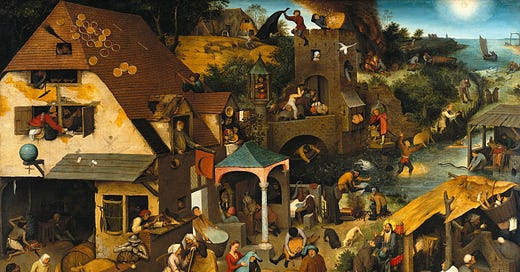The thin line to draw a setting
I am approaching one of the most complex tasks for me, the writing of the setting. The difficulty, as I see it, is that such a book should have a logical structure and present the setting comprehensively, both horizontally (i.e. describe everything at a high level) and vertically (i.e. for each interesting theme the description should be drilled down to the smallest detail). This approach creates problems for me that I cannot solve, even if I take professionally written settings as an example (the reason is that they do not meet my wishes). And that is one of the problems.
If you want to analyse the issue in depth, on the same level as what I wrote above, there is also the question of the relationship between rules and settings. Many believe that the two can be kept separate and this is difficult if you want to create a setting that has special features... or, conversely, it is difficult if the special features of the setting are explained by mechanics written to emphasise those features. Making a 'standard' setting allows you to use any rule with minor tweaks, making a setting with flavor has a different kind of impact. Think of anything related to religion and gods, or to magic (be this either divine or arcane).
So the question boils down to this: is it better to have a single manual with rules and settings? I am not going to give an answer for two main reasons: firstly, you already know how I think, and secondly, everyone has their own view, in which the weighting of pros and cons varies greatly.
The third doubt I have about the setting approach has already been explained in a previous post: is it better to define the game world as a blurred background (as Jim Raggi explains in his GM manual) or as a detailed landscape? I already answered this in that post: a detailed landscape is better, because the blurred palette does not look like a real setting to me. However, since that post, I came to the conclusion that the level of detail should not be taken to extremes (otherwise I’d fall back into the vertical vs. horizontal dilemma I explained above). This non-ultra-detailed approach allows the game world to be sketched out to make it complete, while at the same time giving the GM the freedom to define and customise it. To use the metaphor of paintings by famous painters, I would not do a Bruegel-type painting, but neither would I do a Fontana: a good compromise like an Impressionist would be the ideal choice.
Another question about setting is how to present the history of the game world. Every detail of a setting is set at a particular time in history, but is it also useful to explain how the world evolved to get to that time. And if this is useful, how would you present the history of a world? In my opinion, it is absolutely necessary to explain to the GM what society is like in the present and how it got there: this helps to show how the characters in the game world think and why they behave in a certain way. It is also true that it is not possible to write a treatise on the complete history of a world - again, you have to find the right compromise. As far as the history of the setting of VI·VIII·X is concerned, the solution has been found quite easily: for reasons I will not reveal here, the history of the world begins at a precise moment, about 1400 years before the present. Before that time there are no traces, no information, no evidence. In this sense, history is also 'easy' to handle and enter as an element: everyone knows only this 'small' fraction of time and there is no way to know what happened before.
For those curious, there is a way to finding out what happened: this is part of the Cosmogony, a separate book that I have deliberately kept aside from the setting. While the story is known to everyone, the Cosmogony is a valuable insight only for the GM. After reading a book on Tolkien (‘Tolkien and the Lord of the Rings: A Guide to Middle Earth’ by Colin Duriez, 2001) I realised an essential aspect of the world he created: the myth of its creation. In this way, any story that is coherently inserted into that world seems much more solid and true. In a similar way, but much more limited by my near-zero literary skills, I devised the creation myth that led to the salient facts and characters of the world where the characters move. I trust that this will make every aspect more logical (in terms of cosmogony, not according to the real-world logic!) and help the GM make it come alive and active around the characters.
I think I have bored you far too much, so I will end with a brief summary:
complete but not verbose setting, so as not to burden the reader, and to allow GMs to fill in certain blanks with their own creativity.
setting separate from the rules, because otherwise it leads to overly long manuals (and heaven forbid that the rules can be used in other settings!)
lots of 'precise and concise' concepts for the cornerstones of the setting to give a complete but not ultra-detailed picture
and, in keeping up with the KUP approach, it is necessary to give the GM what he needs to get on with the business of populating the world (i.e. methods for customising the world, as I did in Peronæ... damn it... I haven't published it yet... I made spoilers!)




